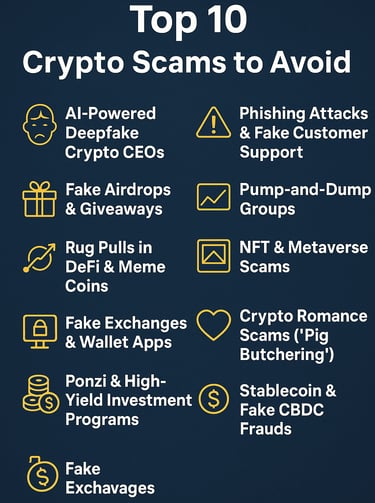Top 10 Crypto Scams to Avoid in 2026 – Complete Guide
Discover the top 10 crypto scams in 2026, from AI deepfakes to rug pulls. Learn red flags, safety tips, and how to protect your investments.
CRYPTO NEWSICO
10/3/20255 min read
Top 10 Crypto Scams to Avoid in 2026 – Complete Guide
Cryptocurrency has grown from a niche digital experiment to a trillion-dollar industry, drawing investors, traders, and innovators from every corner of the globe. With Bitcoin, Ethereum, and thousands of altcoins gaining popularity, millions of people are rushing into the crypto space in 2026, hoping to build wealth and financial independence.
But where there’s money, there are also scams. The decentralized and largely unregulated nature of crypto makes it a fertile ground for fraudsters who prey on inexperienced investors and even seasoned traders. From sophisticated hacking schemes to simple old-fashioned “too good to be true” promises, scams evolve every year, becoming more creative and more dangerous.
If you’re planning to invest, trade, or simply explore the world of digital assets in 2026, it’s crucial to understand the top scams threatening the market right now—and how to avoid them.
Let’s break down the 10 most common crypto scams of 2026, with real-world style explanations, red flags to watch for, and strategies to protect yourself.
1. AI-Powered Deepfake Crypto CEOs
In 2026, artificial intelligence tools are being weaponized by scammers. One of the most alarming trends is deepfake crypto CEOs. Fraudsters create realistic video or audio clips of well-known figures like Vitalik Buterin, Elon Musk, or major exchange executives, claiming to launch new tokens or investment opportunities.
They use these deepfakes in live streams, social media ads, and Telegram groups to lure investors into depositing funds. The scam feels authentic because the AI-generated face and voice look and sound real.
🔴 Red Flags:
A famous crypto personality suddenly promoting a little-known token.
Videos or live calls with slightly distorted facial expressions or robotic speech.
Urgency-driven offers: “Invest today or miss out forever.”
✅ How to Stay Safe:
Always confirm announcements on official verified channels like Twitter, blogs, or official websites. Don’t trust random live streams or forwarded Telegram videos.
2. Fake Airdrops & Giveaways
“Send 1 ETH and get 10 ETH back!” – This scam never dies; it only evolves. In 2026, airdrop scams are more professional-looking than ever. Fraudsters set up entire websites mimicking legitimate projects, offering free tokens to anyone who connects their wallet.
But once you connect, the malicious smart contract drains your wallet. In some cases, the fake airdrop tokens themselves are coded with hidden backdoors.
🔴 Red Flags:
Airdrops asking you to “send crypto first.”
Random messages or emails claiming you won free tokens.
Unverified websites using names similar to real projects.
✅ How to Stay Safe:
Never send money for an airdrop. Only join official community airdrops announced on verified project channels. Always double-check the domain name.
3. Rug Pulls in DeFi & Meme Coins
DeFi (Decentralized Finance) exploded in popularity, and meme coins still attract huge hype in 2026. Unfortunately, this makes them breeding grounds for rug pulls.
Developers launch a flashy new token, create hype with influencers, and attract liquidity. Once enough investors buy in, the developers pull all the liquidity from the pool, leaving holders with worthless tokens.
🔴 Red Flags:
Anonymous or unverifiable developer teams.
No real use case—just hype and memes.
Liquidity not locked or audited.
✅ How to Stay Safe:
Check if liquidity is locked on trusted platforms. Research the project’s team, audits, and community. Don’t invest in meme coins purely based on hype.
4. Fake Exchanges & Wallet Apps
As crypto adoption grows, so do fake platforms. Scammers now launch fake exchanges and mobile wallets that look identical to real ones. Once users deposit money, they either can’t withdraw or the app simply vanishes.
Some even use malicious apps uploaded to Google Play or Apple’s App Store, tricking unsuspecting beginners.
🔴 Red Flags:
Exchange with zero reviews or suspiciously high returns.
Wallet apps asking for unusual permissions.
Websites without HTTPS security.
✅ How to Stay Safe:
Only download apps from official websites. Check reviews and reputation before trusting any new platform.
5. Ponzi & High-Yield Investment Programs (HYIPs)
If you see a crypto project offering “guaranteed 30% daily returns,” run. These Ponzi schemes work by paying old investors with new investors’ money. Eventually, when new sign-ups dry up, the scheme collapses, leaving most investors with nothing.
🔴 Red Flags:
“Guaranteed” profits in volatile crypto.
Referral schemes that prioritize recruitment over actual product.
Vague or nonexistent details on how profits are generated.
✅ How to Stay Safe:
Remember: if it sounds too good to be true, it is. Only trust regulated platforms and investments backed by real-world assets or transparent revenue streams.
6. Phishing Attacks & Fake Customer Support
Phishing scams are as old as the internet, but in 2026, they’ve reached new heights in crypto. Scammers send fake emails, social media DMs, or pop-ups that look identical to official exchanges. They ask you to enter your seed phrase, private key, or login details.
Some even set up fake “customer support” chats pretending to help, only to drain your account.
🔴 Red Flags:
Emails with minor spelling mistakes in domain names.
Support reps asking for your seed phrase (legitimate companies NEVER do this).
Urgent “account suspension” warnings.
✅ How to Stay Safe:
Bookmark official exchange sites, enable 2FA, and never share private keys. Always contact support directly through verified websites.
7. Pump-and-Dump Groups
Telegram, Discord, and Twitter still host pump-and-dump groups in 2026. These groups coordinate to artificially pump a token’s price, convincing outsiders it’s a “moonshot.” Once enough people buy in, the organizers sell, causing the price to crash.
🔴 Red Flags:
Groups promising “inside tips” or “guaranteed moon coins.”
Sudden price spikes with no news or development.
Coordinated shilling on social media.
✅ How to Stay Safe:
Don’t chase hype. Stick to projects with long-term fundamentals, not coins being pushed by anonymous Telegram groups.
8. NFT & Metaverse Scams
Even though the NFT boom has matured, scammers still exploit it in 2026. Fake NFT marketplaces trick users into buying non-existent art. Fraudsters also sell plagiarized NFTs or create “metaverse land sales” for platforms that don’t even exist.
🔴 Red Flags:
NFT projects with no roadmap or community.
Marketplaces without verifiable smart contracts.
“Celebrity NFT drops” that aren’t verified.
✅ How to Stay Safe:
Only buy NFTs on trusted platforms like OpenSea, Blur, or official marketplaces. Always verify contracts and authenticity.
9. Crypto Romance Scams (“Pig Butchering”)
One of the most heartbreaking scams is the rise of romance-based crypto fraud. Scammers build relationships with victims online, gaining trust over weeks or months. Then, they slowly convince them to invest in a fake crypto platform or send money for “joint investments.”
This is also called the “Pig Butchering” scam, and it’s growing rapidly in 2026.
🔴 Red Flags:
Online relationships where the person avoids video calls.
Sudden investment advice from a romantic interest.
Pressure to deposit funds into unknown platforms.
✅ How to Stay Safe:
Never mix romance with finance online. Verify identities, and don’t send money to people you’ve never met.
10. Stablecoin & Fake CBDC Frauds
With many countries launching Central Bank Digital Currencies (CBDCs) in 2026, scammers are exploiting confusion. They launch fake CBDCs, stablecoins, or “government-backed crypto” tokens, tricking people into believing they’re official.
🔴 Red Flags:
Tokens claiming to be “government approved” but not listed by official authorities.
Random websites selling “early access” to new CBDCs.
Promises of fixed high yields from stablecoins.
✅ How to Stay Safe:
Only trust official government portals for CBDCs. Stick to stablecoins with proven track records like USDC or DAI.
Final Thoughts – Stay Ahead of Crypto Scammers in 2026
The crypto world in 2026 is bigger, faster, and more innovative than ever before. But innovation brings risk, and fraudsters will always find new ways to exploit the hype.
The good news? With awareness, research, and cautious investing, you can stay several steps ahead. Remember:
Never share private keys or seed phrases.
Double-check all URLs and announcements.
Avoid “guaranteed returns” schemes.
Stick to trusted exchanges and wallets.
Crypto has the power to create financial freedom, but only for those who protect themselves from traps. Don’t let scammers take your hard-earned money—stay vigilant, stay informed, and invest smart in 2026.




